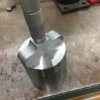One more opinion, then I will shut up... Locking lugs will never maintain full contact because the slop or clearance at the back bridge of the Remington action will allow the firing pin and sear to lift the bolt up therefore the top lug will loose contact in direct perportion to the amount of clearance. Depending on how tight the cartridge fits the chamber that can be corrected somewhat by the shell forcing the bolt lugs into contact.
Eddie in Texas
Eddie in Texas













